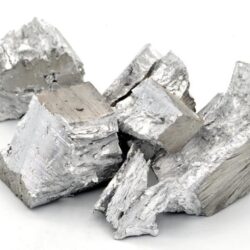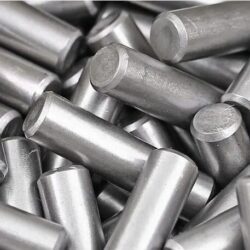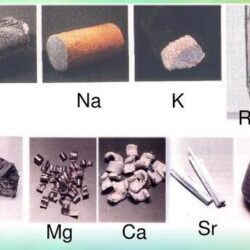gallium (Ga), chemical element, metal of main Group 13 (IIIa, or boron group) of the periodic table. It liquefies just above room temperature.
Gallium was discovered (1875) by French chemist Paul-Émile Lecoq de Boisbaudran, who observed its principal spectral lines while examining material separated from zinc blende. Soon afterward he isolated the metal and studied its properties, which coincided with those that Russian chemist Dmitry Ivanovich Mendeleyev had predicted a few years earlier for eka-aluminum, the then-undiscovered element lying between aluminum and indium in his periodic table.
Periodic table of the elements. Left column indicates the subshells that are being filled as atomic number Z increases. The body of the table shows element symbols and Z. analysis and measurement
Britannica Quiz
Periodic Table of the Elements
Though widely distributed at Earth’s surface, gallium does not occur free or concentrated in independent minerals, except for gallite, CuGaS2, rare and economically insignificant. It is extracted as a by-product from zinc blende, iron pyrites, bauxite, and germanite.
Gallium is silvery white and soft enough to be cut with a knife. It takes on a bluish tinge because of superficial oxidation. Unusual for its low melting point (about 30 °C [86 °F]), gallium also expands upon solidification and supercools readily, remaining a liquid at temperatures as low as 0 °C (32 °F). Gallium remains in the liquid phase over a temperature range of about 2,000 °C (about 3,600 °F), with a very low vapour pressure up to about 1,500 °C (about 2,700 °F), the longest useful liquid range of any element. The liquid metal clings to (wets) glass and similar surfaces. The crystal structure of gallium is orthorhombic. Natural gallium consists of a mixture of two stable isotopes: gallium-69 (60.4 percent) and gallium-71 (39.6 percent). Gallium has been considered as a possible heat-exchange medium in nuclear reactors, although it has a high neutron-capture cross section.
The metal gallium is stable in dry air. Somewhat similar to aluminum chemically, gallium slowly oxidizes in moist air until a protective film forms. On burning in air or oxygen, it forms the white oxide Ga2O3. This oxide can be reduced to the metal when heated at high temperatures in hydrogen, and with gallium metal at 700 °C (1,300 °F), it gives the lower oxide Ga2O. It does not dissolve in cold nitric acid, because, as with moist air, a protective film of gallium oxide forms. Gallium does not react with water at temperatures up to 100 °C (212 °F) but reacts slowly with hydrochloric and other mineral acids to give the gallium ion, Ga3+. The metal does dissolve in other acids to give gallium salts, and it dissolves in alkalies, with the evolution of hydrogen, to give gallates, such as [Ga(OH)4]−, in which gallium appears in the anion. Gallium is amphoteric (i.e., it reacts either as an acid or as a base, depending on the circumstance), reacting with sodium and potassium hydroxide solutions to yield a gallate and hydrogen gas. The halogens attack it vigorously.
In most of its compounds, gallium has an oxidation state of +3 and, in a few, +1 (for example, the oxide, Ga2O). There is no evidence for authentic compounds of gallium in its +2 state. The “dihalides,” for example, contain Ga+ and Ga3+ in a one-to-one ratio. With the Group 15 (Va) elements nitrogen, phosphorus, arsenic, and antimony and the Group 13 elements aluminum and indium, gallium forms compounds—e.g., gallium nitride, GaN, gallium arsenide, GaAs, and indium gallium arsenide phosphide, InGaAsP—that have valuable semiconductor and optoelectronic properties. Some of these compounds are used in solid-state devices such as transistors and rectifiers, and some form the basis for light-emitting diodes and semiconductor lasers. GaN nanowires have been synthesized and used in electronic and optoelectronic nanosystems (that is, extremely small electronic devices that use light in their operation). Of the halides, only gallium trifluoride is ionic; the others have molecular lattices containing dimeric molecules, with formula Ga2X6. The sulfide (GaS), selenide (GaSe), and telluride (GaTe), made directly by combination of the elements at high temperature, are diamagnetic and contain gallium―gallium units with four positive charges (Ga―Ga)4+, in a layer lattice. The hydroxide, formula Ga(OH)3, is amphoteric; it is precipitated from solutions of gallium salts by alkali hydroxides.
Health effects of gallium
Gallium is an element found in the body, but it occurs in a very small amount. For example, in a person with a mass of seventy kilograms, there are 0.7 milligrams of gallium in the body. If this amount of gallium was condensed into a cube, the cube would only be 0.49 millimeters long on one side. It has no proven benefit towards the function of the body, and it most likely is only present due to small traces in the natural environment, in water, and in residue on vegetables and fruits. Several vitamins and commercially distributed waters have been known to contain trace amounts of gallium with less than one part per million. Pure gallium is not a harmful substance for humans to touch. It has been handled many times only for the simple pleasure of watching it melt by the heat emitted from a human hand. However, it is known to leave a stain on hands. Even the gallium radioactive compound, gallium [67Ga] citrate, can be injected into the body and used for gallium scanning without harmful effects. Although it is not harmful in small amounts, gallium should not be purposefully consumed in large doses. Some gallium compounds can actually be very dangerous, however. For example, acute exposure to gallium(III) chloride can cause throat irritation, difficulty breathing, chest pain, and its fumes can cause even very serious conditions such as pulmonary edema and partial paralysis.
Environmental effects of gallium
One controversy with gallium involves nuclear weapons and pollution. Gallium is used to hold some nuclear bomb pits together. However, when the pits are cut and plutonium oxide powder is formed, the gallium remains in the plutonium. The plutonium then becomes unusable in fuel because the gallium is corrosive to several other elements. If the gallium is removed, however, the plutonium becomes useful again. The problem is that the process to remove the gallium contributes to a huge amount of pollution of water with radioactive substances. Gallium is an ideal element to use in the bomb pits, but pollution is destructive to the earth and to the health of its inhabitants. Even if efforts were taken to remove the pollution from the water, it would significantly increase the costs of the procedure of turning plutonium into a fuel by about 200 million dollars. Scientists are working on another method to clean the plutonium, but it could take years to be completed.
ses and properties
Image explanation
The image reflects on puns relating to the origin of the element’s name. Lecoq de Boisbaudran named the element after France (‘Gaul’ in Latin) and also himself, since Lecoq, which means ‘the rooster’ translates to ‘Gallus’ in Latin. A silvery metallic rooster is shown on a background of an antique map of France.
Appearance
Gallium is a soft, silvery-white metal, similar to aluminium.
Uses
Gallium arsenide has a similar structure to silicon and is a useful silicon substitute for the electronics industry. It is an important component of many semiconductors. It is also used in red LEDs (light emitting diodes) because of its ability to convert electricity to light. Solar panels on the Mars Exploration Rover contained gallium arsenide.
Gallium nitride is also a semiconductor. It has particular properties that make it very versatile. It has important uses in Blu-ray technology, mobile phones, blue and green LEDs and pressure sensors for touch switches.
Gallium readily alloys with most metals. It is particularly used in low-melting alloys.
It has a high boiling point, which makes it ideal for recording temperatures that would vaporise a thermometer.
Biological role
Gallium has no known biological role. It is non-toxic.
Natural abundance
It is present in trace amounts in the minerals diaspore, sphalerite, germanite, bauxite and coal. It is mainly produced as a by-product of zinc refining.
The metal can be obtained by electrolysis of a solution of gallium(III) hydroxide in potassium hydroxide.





